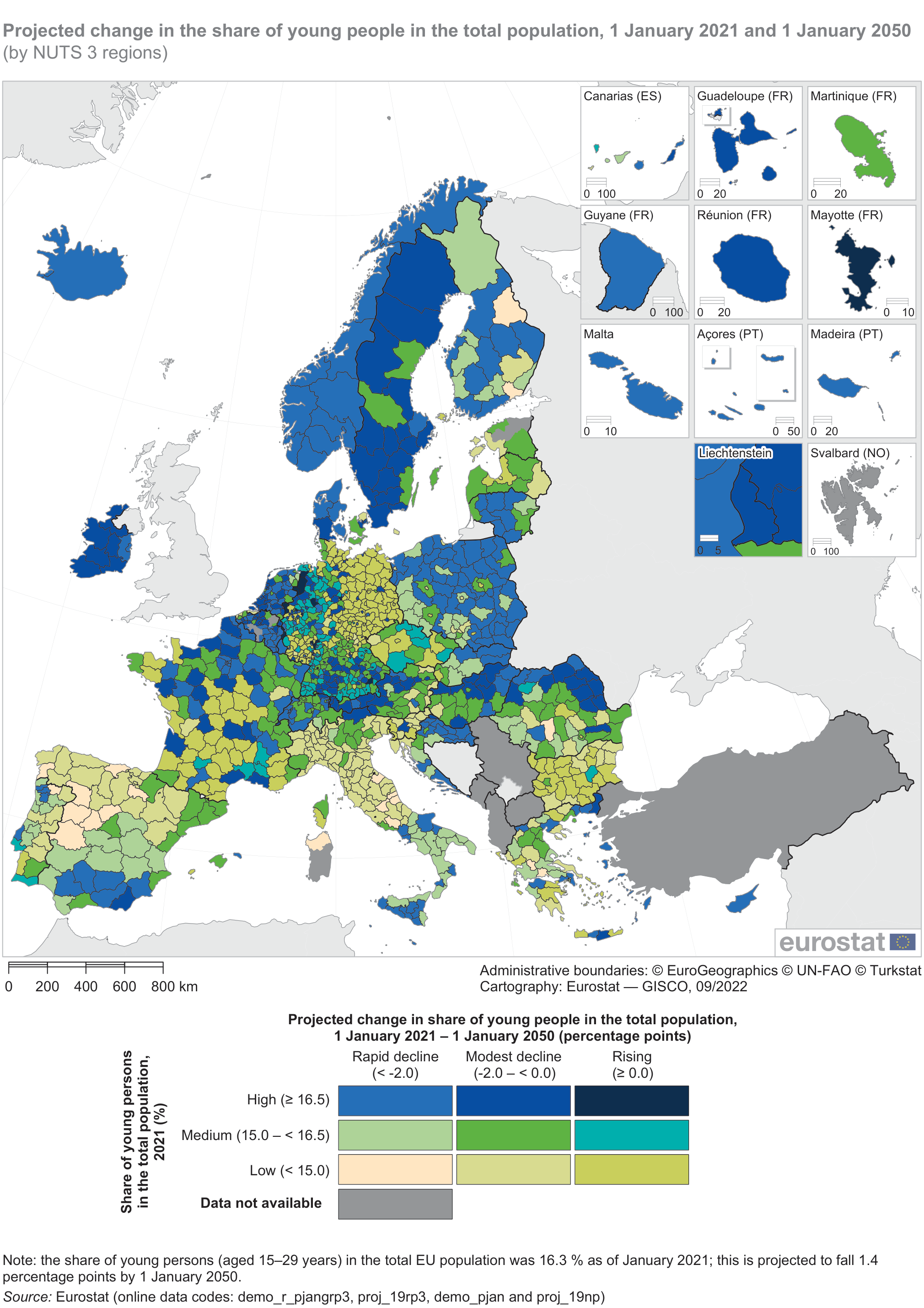As of 1 January 2021, young people (aged 15–29 years) made up some 16.3% of the EU’s total population. Among NUTS level 3 regions, they accounted for more than one quarter of the total population in the Danish capital region of Byen København (26.7%), as well as in the student cities of Overig Groningen in the Netherlands (25.4%) and Heidelberg, Stadtkreis in Germany (25.1%). There were 46 NUTS level 3 regions across the EU where young people accounted for at least one fifth of the total population. These regions were predominantly urban and many university cities and were concentrated across a small number of EU Member States – Belgium, Denmark, Germany, Greece, Spain, France, Cyprus, the Netherlands and Sweden.
Looking into the future and based on Eurostat’s population projections ‘EUROPOP2019’, youths will account for 14.9% of the EU population by 2050, a share 1.4 percentage points lower than their share on 1 January 2021, showing some signs of the progressive ageing of the EU population.
According to these projections, the share of youths was projected to remain constant or continue growing in the 16 NUTS 3 regions which had a relatively high share of young persons in 2021. These regions are almost exclusively located in Germany (14 regions), except for Bezirk Verviers — Deutschsprachige Gemeinschaft in Belgium, and one of the French overseas departments, Mayotte.
Highest projected increase in Germany
Looking in more detail at the projected developments for the youth population, the 10 NUTS 3 regions with the biggest absolute increases – as measured by the projected percentage point change in the share of youths between 2021 and 2050 – were all located in Germany.
At the other end of the range, the 10 regions with the biggest projected falls in their share of youth populations were more widely distributed. Half of them (five regions) were located in Germany, while the other five included two regions from eastern Poland – Chełmsko-zamojski and Przemyski – the capital regions of Dytiki Attiki in Greece and Paris in France, as well as Tâmega e Sousa in Portugal.
Source datasets: demo_r_pjangrp3, proj_19rp3, demo_pjan and proj_19np
The largest relative increases in youth populations across EU regions – as measured by the projected change in the share of youths between 2021 and 2050 in percentage terms – were also recorded in Germany; there were 24 NUTS 3 regions across Germany where the increase in the share of youths is projected to be higher than 30.0%.
At the other end of the range, there were three regions where the share of youths is projected to fall by more than 30.0%: Chełmsko-zamojski (-31.7%), Paris (-32.1%) and Noord- Drenthe in the Netherlands (-35.2%).
Would you like to know more about population statistics in the EU?
You can read more in the dedicated section of the Regions in Europe - 2022 interactive edition or more specifically in the Statistics Explained articles on population statistics at regional level. The corresponding maps in the Statistical Atlas provide a full-screen interactive map experience.
For more information:
- Statistics Explained article on population projections at regional level
- Statistics Explained article on population statistics at regional level
- Dedicated section on population and demography statistics
- Dedicated section on regions and cities
- Database on population and demography statistics
- Database on population projection statistics
- Database on regional statistics
To contact us, please visit our User Support page.
For press queries, please contact our Media Support.


